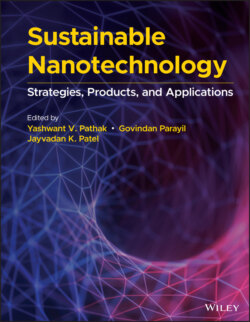Читать книгу Sustainable Nanotechnology - Группа авторов - Страница 23
1.2.3 Biosensors
ОглавлениеBiosensors are tools used to detect and analyze biological elements. Conventional biosensors have their advantages, but they also exhibit several limitations. Nanotechnology, however, eliminates the limitations of conventional methods. In fact, as the material dimensions are minimized, the applicability of biosensors is improved [47]. There are several nanoparticle‐based biosensors that can help detect pathogenic viruses. For example, the development of quantum dots‐based imaging and capturing systems for selective capturing and detection of the HIV in whole blood. It is a dual‐stain imaging system for the detection of HIV1 gp120 envelope glycoprotein. It is also capable of obtaining countable imaging. This system can work with 10 μl of a blood sample, is portable, and is highly cost‐effective compared to other methods [48]. For the detection of multiple viruses, the fluorescence characteristic of AgNPs is quite useful for optical biosensors. Using silver nanoclusters, biosensors have been prepared for the detection of specific DNA sequences of HIV, hepatitis B virus (HBV) and human T‐lymphotropic virus type I (HTLV‐I) gene. Before binding to the DNA sequence, these nanoclusters exhibited high fluorescence activity. After attaching to the sequence, however, the fluorescence intensity decreased, allowing the target sequences to be detected [49]. Additionally, magnetic nanoparticles have also been utilized for virus detection. Amino functional carbon‐coated magnetic nanoparticles, for example, have been used to distinguish hybridization of HBV nucleic acids [50, 51].
MicroRNAs (miRNAs) are small noncoding RNAs that regulate gene expression by inhibiting translation and play a role in RNA degradation [52–54]. Currently, miRNA detection has several limitations such as sensitivity and selectivity [55]. Additionally, the current methods of miRNA detection, including northern blotting, microarray analysis, and RT‐PCR, are high in cost, complicated to handle, and do not produce stable results [56]. Tumor‐derived miRNA‐141 deregulation in human plasma is an important biomarker for blood‐based detection of various cancers, such as prostate [57], colons [58], and ovarian [59]. An electrochemical immunosensor composed of modified gold electrodes, reduced graphene oxide, and CNTs has been developed for the detection of the miR‐141 gene. With this method, the detection limit was down to 10fM [60]. Similar to miRNA‐141, miRNA‐155 is another biomarker for diagnosis of diffuse large B‐cell lymphoma [61]. Oligo‐hybridization‐based electrochemical biosensors can be used for its detection. These biosensors utilized GNPs on sheets of graphene oxide situated on glassy carbon electrodes. This particular biosensor exhibited higher selectivity as it was able to distinguish between complementary target miRNAs, three‐base mismatch, and noncomplementary miRNAs.
It also was capable of directly detecting miR‐155 in plasma without any need for sample preparation, extraction, and amplification [62]. Another example of a useful biomarker is miRNA‐21, the most frequently upregulated miRNA in breast cancer and can also be used for early diagnosis and drug development for cardiovascular disease [63]. An electrochemical biosensor based on a metal ion functionalized titanium phosphate nanospheres is a sensitive and selective tool for detecting miR‐21. The addition of cadmium ion to titanium phosphate nanosphere exhibited improvement of the electrochemical signals by five times [64, 65].
